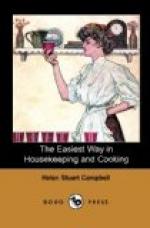Muscle being the first consideration in building up a strong body, we need first to find out the values of different foods as flesh-formers, healthy flesh being muscle in its most perfect condition. Flesh and fat are never to be confounded, fat being really a species of disease,—the overloading of muscle and tissue with what has no rightful place there. There should be only enough fat to round over the muscle, but never hide its play. The table given is the one in use in the food-gallery of the South Kensington Museum, and includes not only the nutritive value, but the cost also, of each article; taking beef as the standard with which other animal foods are to be compared, beef being the best-known of all meats. Among vegetables, lentils really contain most nourishment; but wheat is chosen as being much more familiar, lentils being very little used in this country save by the German part of the population, and having so strong and peculiar a flavor that we are never likely to largely adopt their use.
About an equal amount of nourishment is found in the varied amounts mentioned in the table which follows:—
TABLE.
Cost about Eight ounces of lean beef (half-pound) 6 cts. Ten ounces of dried lentils 7 cts. Eleven ounces of pease or beans 5 cts. Twelve ounces of cocoa-nibs 20 cts. Fourteen ounces of tea 40 cts. Fifteen ounces of oatmeal 5 cts. One pound and one ounce of wheaten flour 4 cts. One pound and one ounce of coffee 30 cts. One pound and two ounces of rye-flour 5 cts. One pound and three ounces of barley 5 cts. One pound and five ounces Indian meal 5 cts. One pound and thirteen ounces of buckwheat-flour 10 cts. Two pounds of wheaten bread 10 cts. Two pounds and six ounces of rice 20 cts. Five pounds and three ounces of cabbage 10 cts. Five pounds and three ounces of onions 15 cts. Eight pounds and fifteen ounces of turnips 9 cts. Ten pounds and seven ounces of potatoes 10 cts. Fifteen pounds and ten ounces of carrots 15 cts.
Now, because tea, coffee, and cocoa approach so nearly in value as nutriment to beef and lentils, we must not be misled. Fourteen ounces of tea are equivalent to half a pound of meat; but a repast of dry tea not being very usual, in fact, being out of the question altogether, it becomes plain, that the principal value of these foods, used as we must use them, in very small quantities, is in the warmth and comfort they give. Also, these weights (except the bread) are of uncooked food. Eight ounces of meat would, if boiled or roasted, dwindle to five or six, while the ten ounces of lentils or beans would swell to twice the capacity of any ordinary stomach. So, ten pounds of potatoes are required to give you the actual benefit contained in the few ounces of meat; and only the Irishman fresh from his native cabin can calmly consider a meal of that magnitude, while, as to carrots, neither Irishman nor German, nor the most determined and enterprising American, could for a moment face the spectacle of fifteen pounds served up for his noonday meal.




